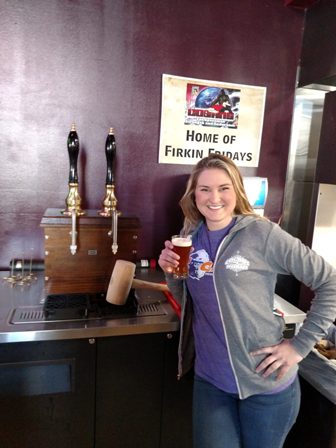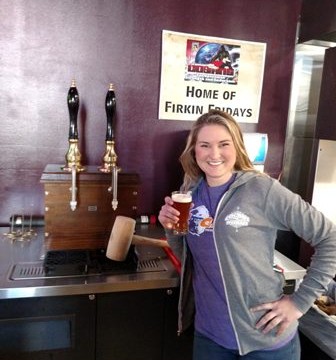By Elizabeth Erschens
Okay, class, raise your hands. Who knows what a real ale is? Until relatively recently, most people in this country wouldn’t have known the answer. The process of brewing real ale goes back to the origins of beer – some 6,000 years ago – and remained popular until beer was mass produced using filtration, pasteurization, and forced carbonation. Thankfully, a grassroots political group known as Campaign for Real Ale (CAMRA) was formed in England to save the traditional beer making process.
Real ale, also called cask ale or live ale, is distinguished by its traditional ingredients, brewing process, and service: directly from the secondary fermentation cask (also known as a firkin – the name of the most popular size cask used by brewers).The ingredient that controls the fermentation is yeast. Cask ales are usually brewed with a top fermenting ale yeast that is more vigorous, faster, and produces a more distinctive flavor than lager yeast. Until only 500 years ago, all beers brewed were ales as lager yeast didn’t even exist.
Historically, beer could only be brewed in warmer climates since ale yeast doesn’t thrive in cold temperatures. Its origin was a mystery until only recently, when a genetics professor and a few international cronies stripped the DNA of lager yeast and realized it was the product of … incest! Yes, some domesticated yeast that preferred colder temps must have stowed away and crossed the ocean because it did not exist naturally in Europe! The trip must have been lonely for the cold loving yeast because it did the wild thing with its distant cousin, Bavarian ale yeast, and produced a new yeast that could ferment in the cooler caves of Germany.
Just looking at that dry yeast you store for baking, you might not realize yeast is a living organism. Not only are they alive in beer, there are a lot of them! Even the 5 gallon batch typically brewed at home needs billions of yeast cells for a good fermentation. That incest thing must have been sheer instinct because those billions of yeast cells eat and reproduce around the clock to give us the liquid libation we love: the life of a yeast cell is pretty much one of gluttony and promiscuity.
One must understand how yeast works to comprehend the difference between live cask beer and pasteurized, force-carbonated beer. Cask ale is naturally carbonated and alive. Both beers begin their fermentation with live yeast because yeast is necessary create the alcohol. Both the alcohol and carbon dioxide that create natural carbonation are actually byproducts of yeast activity. Yeast need to feed to reproduce and form enough cell for fermentation. When the yeast eats the sweet malt in the wort, they must break down the malt’s glucose, resulting in these two byproducts which makeup beer. Because of this process, beer is sometimes jokingly referred to as yeast piss or poop.
Fermentation is where the road forks for cask ale. While most bottled and kegged beer complete the entire fermentation process in the same vessel, real ale is transferred to a cask to finish the process. It is necessary to transfer the yeast cells into the cask with the beer to complete secondary fermentation and natural carbonation.
Most bottle and kegged beer is forced carbonated so live yeast isn’t necessary once the fermentation is complete. At the end of fermentation, the brewer commits genocide by flash heating the billions of yeast and then filters the beer to hide the dead bodies.
Unfiltered cask beer is still cloudy after fermentation. Finings (clarifying agents) such as gelatin or isinglass (made with the swim bladder of a fish -!) are added. Before fancy bottles, people used to transport wine in fish bladders and recognized the clarifying properties.
After the beer has clarified, it is “dropped bright” and ready to be served fresh. The freshness and lower fizz of natural carbonation is the draw for cask beer, but the cask itself can present problems for real ales. Since cask ale is not force carbonated (kegged beer is), there is no pressure to push the beer from the cask. The cask also demands you consume the beer quickly as cask aren’t airtight and the oxygen will quickly stale the real ale.
To keep the oxygen level in the cask as low as possible, a beer engine is used to serve the cask ale. Traditionally, it is a hand pump, or pull, that the bartender engages; beer flows into the piston chamber through a one way valve, when it is pulled again, beer flows out the tap and the space in the chamber refills with more beer.
Not all cask beer is served with a traditional beer engine. An electric pump can be substituted when haste is needed. There are also modern establishments actually pushing a small amount of CO2 to fill the space voided by the beer so it doesn’t go stale as fast. However, purists may assert that the CO2 diminishes the fresh flavor and mouth-feel of real beer.
If you don’t have a beer engine and don’t want to use CO2, you can empty the cask by driving the tap directly in the keystone of the cask with a mallet, and dispensing by gravity. Many of local breweries have begun serving real ale this way and are creating different beers by adding flavors or hops directly to the cask.
Other local establishments have begun serving real ale as its reputation renews. I was able to sample a couple of real ales at the new Cogans North in Norfolk while chatting with the bartender about their beer engine and the popularity of their real ale. Next, I plan to belly up to the bar at DoG Street Pub, in Colonial Williamsburg’s Merchants Square, as they have long featured real ale to their beer selection.
Back Bay Brewing Company will host the Kiss My Cask Real Ale Festival on March 7. The all cask fest will feature 22 breweries including Evolution, Stone, Green Flash, New Belgium, Heavy Seas, Champion, Starr Hill and the local guys.
As popularity rebounds, I expect we will see real beer popping up at many more locations. I, personally, think that this is a good thing and am very thankful to the founders of CAMRA for spearheading the return of real beer.
Elizabeth Erschens is the owner of Home Brew USA with locations in Norfolk at Janaf and in Hampton





